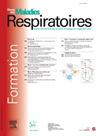Fine-tuning levels of filamins A and B as a specific mechanism sustaining Th2 lymphocyte functions
IF 0.5
4区 医学
Q4 RESPIRATORY SYSTEM
引用次数: 0
Abstract
Introduction
Asthma is a chronic inflammatory disease of lower airways that affects nearly 400 million people worldwide. Nearly half of asthmatic patients present a high type-2 inflammation characterized by a massive recruitment of T helper 2 (Th2) lymphocytes producing type 2 cytokines, eosinophilia and high levels of IgE. Treatments targeting type 2 cytokines and their receptors but also targeting IgE are already used in clinics. An attractive therapy would consist in targeting the recruitment of Th2 lymphocytes to inflammatory sites. We previously showed that the ASB2 gene that encodes the specificity subunit of an E3 ubiquitin ligase belongs to the core set of Th2-specific genes (Cancer Immunol Res 2019.7: 1332–1344).
Methods
ASB2 knockout mice and small molecules were used to modulate the levels of ASB2α and its substrates, filamins a and b (FLNa/b), in mouse primary Th2 lymphocytes and/or PBMC from healthy donors. In vitro experiments including global transcriptomic and proteomic approaches, high content and live imaging, as well as several immunological techniques were used to decipher the role of ASB2α in Th2 lymphocytes. In vivo mouse models of airway inflammation and asthma were used to investigate the role of the ASB2α in type 2 inflammation and determine whether the ASB2α-FLNa/b axis represents a therapeutic opportunity in Th2-driven diseases.
Results
Here, we show that ASB2α triggers ubiquitylation and proteasomal degradation of FLNa/b in Th2 lymphocytes. As a consequence, Th2 lymphocytes exhibit lower levels of FLNa/b proteins compared to naïve CD4 + T lymphocytes or other T helper subsets, associated with an elongated shape and a specific dynamic migration pattern depending on integrin αVß3 activation. Furthermore, we show decreased recruitment of Th2 lymphocytes in inflamed lungs of ASB2α-deficient mice submitted to ovalbumin or house dust mite induced airway inflammation, associated with decreased eosinophilia and decreased type 2 cytokine production. Using a model of passive asthma that relies on the injection of ovalbumin-specific Th2 lymphocytes and ovalbumin inhalations, we show that mice that received ASB2α-deficient or accumulating FLNa/b Th2 lymphocytes exhibit decreased airway inflammation but also mucus secretion and remodeling of the airways compared to mice receiving control Th2 lymphocytes.
Conclusion
In conclusion, our study highlights the key role of a fine regulation of FLNa/b levels in Th2 lymphocyte functions as a driver of Th2-dependent airway inflammation. Our results show that augmenting FLNa/b levels in Th2 lymphocytes benefits in asthma features, indicating that ASB2α and its substrates FLNa/b may represent novel pharmacological targets in type 2 pathologies (Preprint (v1) Res. Square, [https://doi.org/10.21203/rs.3.rs-3878460/v1]).
丝蛋白A和B的微调水平是维持Th2淋巴细胞功能的一种特殊机制
哮喘是一种慢性下呼吸道炎症性疾病,影响全球近4亿人。近一半的哮喘患者表现为高度2型炎症,其特征是大量募集T辅助2 (Th2)淋巴细胞产生2型细胞因子、嗜酸性粒细胞增多和高水平的IgE。针对2型细胞因子及其受体的治疗,以及针对IgE的治疗已经在临床中使用。一种有吸引力的治疗方法是将Th2淋巴细胞募集到炎症部位。我们之前发现,编码E3泛素连接酶特异性亚基的ASB2基因属于th2特异性基因的核心集合(Cancer Immunol Res 2019.7: 1332-1344)。方法利用sasb2基因敲除小鼠和小分子调节小鼠原发Th2淋巴细胞和/或健康供体PBMC中ASB2α及其底物、丝蛋白a和b (FLNa/b)的水平。体外实验包括整体转录组学和蛋白质组学方法,高含量和实时成像以及多种免疫学技术来破译ASB2α在Th2淋巴细胞中的作用。采用小鼠气道炎症和哮喘模型研究ASB2α在2型炎症中的作用,并确定ASB2α- flna /b轴是否代表th2驱动疾病的治疗机会。结果ASB2α可触发Th2淋巴细胞的泛素化和FLNa/b的蛋白酶体降解。因此,与naïve CD4 + T淋巴细胞或其他T辅助亚群相比,Th2淋巴细胞表现出较低水平的FLNa/b蛋白,这与细长的形状和依赖于整合素αVß3激活的特定动态迁移模式有关。此外,我们发现asb2 α-缺陷小鼠在卵清蛋白或尘螨诱导的气道炎症中,炎症肺中Th2淋巴细胞募集减少,与嗜酸性粒细胞减少和2型细胞因子产生减少有关。通过一个依赖于卵清蛋白特异性Th2淋巴细胞注射和卵清蛋白吸入的被动哮喘模型,我们发现,与接受对照Th2淋巴细胞的小鼠相比,接受asb2 α-缺陷或FLNa/b Th2淋巴细胞积累的小鼠表现出气道炎症减少,粘液分泌和气道重塑也有所减少。总之,我们的研究强调了FLNa/b水平在Th2淋巴细胞功能中的精细调控作为Th2依赖性气道炎症的驱动因素的关键作用。我们的研究结果表明,Th2淋巴细胞中FLNa/b水平的增加有利于哮喘特征,这表明ASB2α及其底物FLNa/b可能是2型病理的新药理靶点(Preprint (v1) Res. Square, [https://doi.org/10.21203/rs.3.rs-3878460/v1]])。
本文章由计算机程序翻译,如有差异,请以英文原文为准。
求助全文
约1分钟内获得全文
求助全文
来源期刊

Revue des maladies respiratoires
医学-呼吸系统
CiteScore
1.10
自引率
16.70%
发文量
168
审稿时长
4-8 weeks
期刊介绍:
La Revue des Maladies Respiratoires est l''organe officiel d''expression scientifique de la Société de Pneumologie de Langue Française (SPLF). Il s''agit d''un média professionnel francophone, à vocation internationale et accessible ici.
La Revue des Maladies Respiratoires est un outil de formation professionnelle post-universitaire pour l''ensemble de la communauté pneumologique francophone. Elle publie sur son site différentes variétés d''articles scientifiques concernant la Pneumologie :
- Editoriaux,
- Articles originaux,
- Revues générales,
- Articles de synthèses,
- Recommandations d''experts et textes de consensus,
- Séries thématiques,
- Cas cliniques,
- Articles « images et diagnostics »,
- Fiches techniques,
- Lettres à la rédaction.
 求助内容:
求助内容: 应助结果提醒方式:
应助结果提醒方式:


